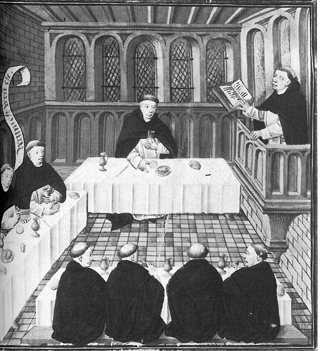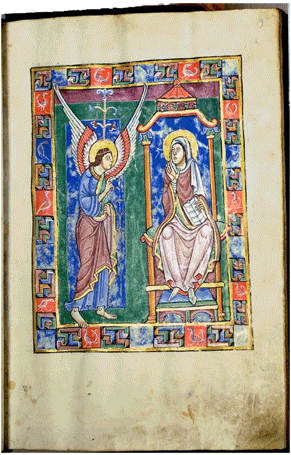

f we ask who "read" the St. Albans Psalter and Sir Orfeo, we betray a modern bias of print culture where private silent reading is the norm. We need to remove that bias to understand how medieval works were received. A better question might be, "How did people experience these two texts?" It is difficult for us to know the exact social milieu, as there is not much evidence, except indirectly in the texts themselves. However, it appears that medieval practice included public readings of written texts (that is, reading manuscripts aloud in a group); a "reading by seeing" through contemplating the illustrations; and, to a lesser extent, voiced and silent private reading.

In her book Public reading and the reading public in late medieval England and France, Janet Coleman discusses how medieval society did not just transition from an oral to a written culture. There was a tradition of what she calls aurality that remained throughout the Middle Ages into the Renaissance. Coleman describes orality as the tradition of an oral performance by bards or minstrels without a written text. They performed from memory, often accompanied by a harp or rote. "Aurality is distinguished from 'orality' by its dependence on a written text as the source of the public reading" (Coleman 28). Because we read in private, we tend to underestimate the medieval preference for reading as a social event. The event could be for devotional or liturgical purposes, as was the case for the St. Albans Psalter. The event could be festive, as might have been the case for a reading of Sir Orfeo. Although, depending on the context, readers could have performed Sir Orfeo during more serious occasions along with spiritually edifying material. In many of these cases, people received the texts as listeners.
Aurality contains an emphasis on performance. The reader can interact with the audience, who might speak up, and the interaction might cause a straightforward, sarcastic, or ironic reading of the texts. Different performances of the same written text can produce different meanings.
Coleman writes that the public reading of devotional texts in a monastery or even during meals at a manor or more humble home had "spiritual benefits" in that it placed "one individual in the exalted role as mediator of a body of highly valued texts" who became "the most powerful individual in the room" (Coleman 139). That person could control the audience to keep their minds on higher matters and "prevent any tongues speaking 'vain or hurtful things'" (Coleman 140).
Clerical-religious private reading: Lector reads to monks
at meal.Copyright Biblioth’┐Įque Royale Albert Ier, Brussels.
(Coleman 112C)
There were professional readers, both laymen and from the clergy, who read to upper-middle and upper-class "literate" audiences. (Authors such as Geoffrey Chaucer were expected to publicly perform readings of their works.) However, as Mortimer J. Donovan writes in The Breton Lay: A Guide to Varieties, "It should not be thought’┐Įthat during the thirteenth [or fourteenth] century the Breton lay belonged exclusively to one class" (Donovan 123). Donovan writes that "as the thirteenth century advanced’┐Įand English became the language of the cultivated class as well, the Breton lay became available’┐Įto any user of English regardless of rank" (Donovan 124).
Return to topIn the book From Memory to Written Record: England 1066-1307, M. T. Clanchy writes that by the twelfth century people associated the terms clericus (clerics) with litteratus (literates) and laicus (layman) with illitteratus (illiterates). However, not only were those terms relative, but they meant something different than how we think of them today. "As clericus and litteratus both meant learned, it followed that a person of no great book learning was a laicus, a 'layman,' even if he were a monk or a priest" (Clanchy 227). One could know letters and some Latin but still be illiteratus because one did not know the Latin historians, orators, and mathematicians. Literacy was also a challenge because there were several languages involved: Latin and the vernaculars (Old French and English).
According to Clanchy, literacy grew after the Norman Conquest for practical purposes. There was a greater need for written documents "applied to mundane purposes of government, property-owning and commerce" (Clanchy 334). This made a certain level of literacy necessary for all levels of society.
Return to top
The St. Albans Psalter was produced for and presented to Christina of Markyate by her patron, Geoffrey, Abbot of St. Albans. "The translation of Pope Gregory’┐Įs words into French suggest that Christina read French rather than Latin, though her biographer says nothing about her literacy or linguistic abilities" (Clanchy 191). The "Chanson d’┐ĮAlexis" is also in Old French. However, liturgical books were popular for the clergy and laymen. Even if one could not read, the texts became familiar from constant repetition. One can assume that Christina would have been familiar with some Latin.
It is also unlikely that Christina of Markyate could write, as that was considered a different skill done by scribes. It would not be something done by an upper-class woman, even one who became a cleric. In fact, writing had a negative connotation in that it "implanted forgetfulness in the soul" (Clanchy 193). In medieval iconography, the devil is often shown as a writer.
It is interesting to note that the St. Albans Psalter is the earliest source to contain a representation in an Annunciation image of the Virgin Mary reading (even though the pages are blank). This became a standard way to show Mary. Previous images of the Annunciation usually showed Mary spinning.
The Annunciation Luke 1:288-35
from the St. Albans Psalter
(Hildesheim, Dombibliotheck MS St. Godehard 1)
showing the Virgin Mary reading.
A beautiful, expensive manuscript, such as the St. Albans Psalter, is a large volume, probably "designed to rest on lecterns at eye level and display their texts in bold lettering’┐Įenhanced by illumination" (Clanchy 109). It would have been for viewing as well as reading.(For a comprehensive discussion of the St. Albans Psalter manuscript, see The Auchinleck Manuscript and The St Albans Psalter: A Study of Materiality.)
Pope Gregory the Great (i.e., Pope Gregory I) endorsed using images in worship particularly so the illiterate could "read by seeing." That the Psalter contains more than 200 illustrations shows that it had a visual dimension, and people, illiterate and literate, could meditate on the images. The St. Albans Psalter would be experienced in a number of ways. In a social context one would:
Then, silently, in private, one would:
In his introduction to The Breton Lays in Middle English, Thomas C. Rumble writes that the Breton lays were like modern short stories. The lays did not have the intricate courtly plots of the romances and "were brief enough for one occasion" (Rumble vii), where they could be performed in a hall or manner or town center. The lays usually focus on one character who goes through a series of critical situations and comes to a happy ending.
The three manuscripts (MS Auchinleck, MS Harley 3810, and MS Ashmole 61) that contain Sir Orfeo do not have beautiful illuminations like the St. Albans Psalter. (For a detailed discussion and comparison of the Auchinleck manuscript and the St. Albans Psalter, see The Auchinleck Manuscript and The St Albans Psalter: A Study of Materiality.) These manuscripts were meant to be read, most likely, in public rather than private readings.
Evidence of aurality is in the text of Sir Orfeo itself. The text begins with the narrator or reader describing the nature of Breton lays. The lays that had at one time been sung to the harp are now written down: "We redeth oft and findeth y-write, / And this clerkes wele it wite, / Layes that ben in harping" (1-3). Kings would hear (in other words, they were read to) the marvels in the lays: "when kinges might ovr y-here / Of ani mervailes that ther were" (17-18).
It is central to Sir Orfeo that he is a harper par excellence, which R.H. Nicholson in "Sir Orfeo: A 'Kinges Noote'" believes "represents the good order" (Nicholson 163) that Orfeo restores to his kingdom. (See Sir Orfeo and the Power of the Harp for a discussion of the effect Orfeo’┐Įs harp has on wild beasts, the Faery King, and the faithful steward.)
Return to topAccording to Murray J. Evans in Rereading Middle English Romance, where he compares Sir Orfeo in three different manuscript collections or miscellanies, "manuscript context, and varying versions of texts, can have generic implications, sometimes even differing ones for the same work" (Evans 102). Sir Orfeo is contained within three manuscripts as follows:
In his comparison of Sir Orfeo in the three collections, Evans found the most Celtic fairy-world material in MS Auchinleck. The other two manuscripts, which have a religious bent, focus more on the marital love between Orfeo and Heurodis. MS Ashmole 61 contains an extended final prayer. From the context of Sir Orfeo and the de-emphasis on the supernatural elements in the story in the last two manuscripts, one can deduce different meanings for the story. (For a more comprehensive discussion of the Celtic and English elements of Sir Orfeo, see From Orpheus to Sir Orfeo: The Anglicization of a Myth.)
Sir Orfeo could be seen as political commentary as well. In "The Son of Orfeo: Kingship and Compromise in a Middle English Romance, " Oren Falk points out that although Sir Orfeo is restored as king, the ending "might not be so unequivocally happy as it first appears" (Falk 247) because a steward rather than Orfeo's heir succeeds him to the throne after Orfeo's death. Sir Orfeo can be seen as a conflation of the troubled reign of King Edward II, who did have an heir but who was deposed and became a martyr after his death, with the English concerns regarding heirs and succession.
The audience could experience Sir Orfeo, then, as light entertainment, more serious instructional material about marital love, or political commentary, depending on the social setting. Different uses of the text might account for the differences in the three manuscripts and the placement of Sir Orfeo in the collections.
Return to topSince we do not have direct evidence of the how medieval audiences experienced the St. Albans Psalter or Sir Orfeo, we can only speculate. However, it appears that public reading was important for both devotional and secular texts. The extent to which the clergy and laymen could read in Latin, French, and English varied. However, there was a strong medieval preference to read or listen in a social setting. Images were important, particularly in liturgical and devotional material to help worshipers "read by seeing." The experience and meaning of texts also varied, as we can guess from how they were placed in manuscript collections.

| Return to top | Return Home |
Jane Minogue is responsible for the contents of this website,
with full rights reserved.
No one may quote or use the ideas stated herein without proper attribution.
This website was created expressly for the English 630ML: The Technology of Textuality class,
taught at California State University, Northridge (Click here for information on the class.).